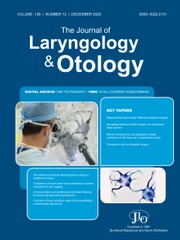Article contents
Nasopharyngeal endoscopy adds to reliability of clinical diagnosis of infectious mononucleosis
Published online by Cambridge University Press: 08 March 2006
Abstract
Frequently, the clinical picture in the oropharynx alone does not lend itself to a reliable differentiation between acute pharyngotonsillitis in infectious mononucleosis and a streptococcal inflammation. Such a differentiation, however, is essential for the indication of antibiotic therapy. Therefore, it was the aim of the present study to investigate whether or not endoscopic verification of larger-than-normal lymphatic tissue with fibrinous membranes in the nasopharynx would enhance the reliability of diagnosis.
Fifty hospitalized patients exhibiting the clinical picture of acute pharyngotonsillitis were examined for the following parameters: nasopharyngeal endoscopy, determination of glutamine-oxaloacetic transaminase (GOT), glutamine-pyruvic transaminase (GPT), C-reactive protein (CRP), erythrocyte sedimentation rate (ESR), leucocytes and haemogram, antibodies to viral capsid antigen (VCA)-IgM, Epstein-Barr virus nuclear antigen (EBNA), and cytomegalovirus (CMV).
In 24 patients with acute tonsillitis/peritonsillar abscess, and in 26 patients with infectious mononucleosis, the total leucocyte count in the blood and the blood/erythrocyte sedimentation rate were comparable. Atypical lymphocytes or absolute lymphocytosis were not seen in acute tonsillitis, but were found in 88.5 per cent of patients with infectious mononucleosis. Elevated transaminase levels were noted in 77 (GOT) and 88.5 per cent (GPT) of patients with infectious mononucleosis, and in acute tonsillitis in 4.2 (GOT) and 12.5 per cent (GPT) of patients. The CRP was higher than normal in 91.7 per cent of patients with acute tonsillitis, and in 57.7 of patients with infectious mononucleosis. In none of the patients with acute tonsillitis was lymphatic tissue with fibrinous membranes seen in the nasopharyngeal cavity. In contrast, nasopharyngeal endoscopy in infectious mononucleosis was positive in 24 out of 26 patients. Hence, the sensitivity was 92.3 per cent, the specificity 100 per cent, and the prediction value for a positive test turned out to be 1.
Endoscopy of the nasopharngeal cavity employed as a simple and supplementary procedure adds to the reliability of diagnosis of infectious mononucleosis.
- Type
- Research Article
- Information
- Copyright
- © Royal Society of Medicine Press Limited 2001
- 6
- Cited by




